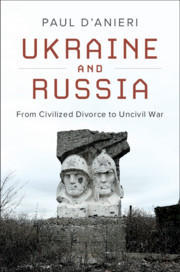Book contents
- Ukraine and Russia
- Ukraine and Russia
- Copyright page
- Dedication
- Contents
- Maps
- Tables
- Acknowledgments
- Additional material
- 1 The Sources of Conflict over Ukraine
- 2 New World Order? 1989‒1993
- 3 Hope and Hardship, 1994‒1999
- 4 Autocracy and Revolution, 1999‒2004
- 5 Reform and Reversal, 2004‒2010
- 6 Viktor Yanukovych and the Path to Confrontation, 2010‒2013
- 7 From Revolution to War, 2013‒2015
- 8 Conclusion: Ukraine, Russia, and the West ‒ from Cold War to Cold War
- Index
6 - Viktor Yanukovych and the Path to Confrontation, 2010‒2013
Published online by Cambridge University Press: 01 November 2019
- Ukraine and Russia
- Ukraine and Russia
- Copyright page
- Dedication
- Contents
- Maps
- Tables
- Acknowledgments
- Additional material
- 1 The Sources of Conflict over Ukraine
- 2 New World Order? 1989‒1993
- 3 Hope and Hardship, 1994‒1999
- 4 Autocracy and Revolution, 1999‒2004
- 5 Reform and Reversal, 2004‒2010
- 6 Viktor Yanukovych and the Path to Confrontation, 2010‒2013
- 7 From Revolution to War, 2013‒2015
- 8 Conclusion: Ukraine, Russia, and the West ‒ from Cold War to Cold War
- Index
Summary
Under Viktor Yanukovych, Ukraine became increasingly autocratic. His concentration of political power and economic assets engendered opposition, but Ukraine seemed stable. While Yanukovych turned Ukraine toward Russia, making significant concessions in return for cheaper energy, he resisted the economic integration that Putin sought, hoping instead for a more popular Association Agreement with the EU. His efforts to play Russia and the EU against one another made Ukraine’s status a zero-sum game internationally. By 2013, it looked like Russia was primed to finally achieve the goal of reeling Ukraine back in, as Yanukovych succumbed to Russian pressure and delayed signing the EU Association Agreement.
- Type
- Chapter
- Information
- Ukraine and RussiaFrom Civilied Divorce to Uncivil War, pp. 175 - 210Publisher: Cambridge University PressPrint publication year: 2019

